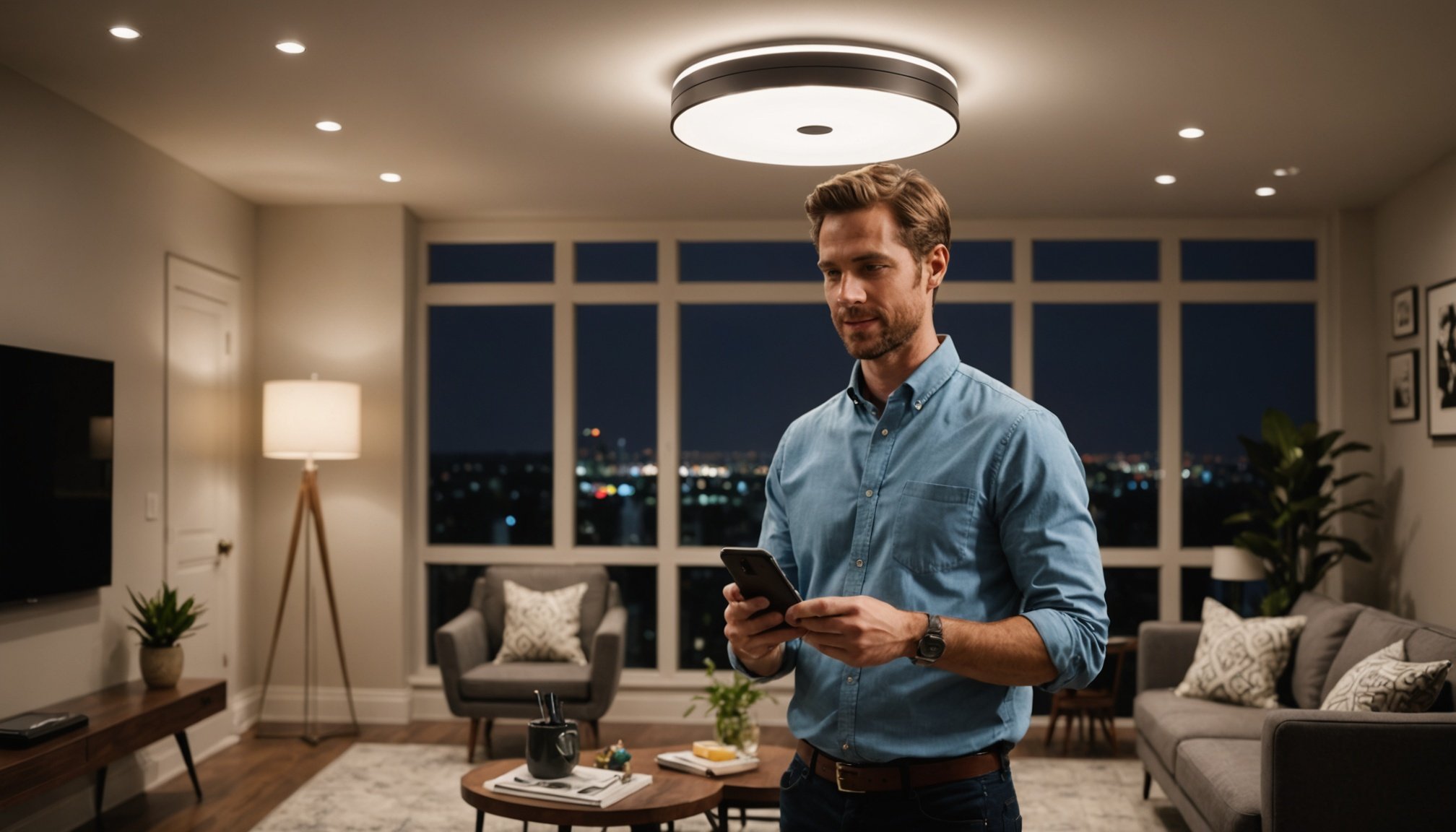Understanding Smart Home Lighting Systems
Smart home lighting systems are revolutionising the way we manage and interact with home environments. They offer unparalleled ambiance customization, allowing homeowners to tailor the lighting to suit various moods and activities. Unlike traditional lighting, smart systems can be controlled remotely using apps or voice commands, integrating technology seamlessly into home life.
A typical smart home lighting setup includes three key components: smart bulbs, controllers, and a central hub. Smart bulbs are designed to replace standard bulbs, offering features like color change and dimming capabilities. Controllers, which can be mobile devices or smart assistants, facilitate ease of use, enabling users to adjust settings without physical switches. The central hub acts as a command center, ensuring all devices communicate effectively to operate as a cohesive unit.
In the same genre : Revolutionizing document management: essential smartphone scanning techniques for maximum efficiency
The benefits of incorporating smart lighting systems into home design are manifold. They enhance energy efficiency by optimizing power consumption based on usage patterns. Additionally, these systems provide security advantages through automated scheduling, deterring potential intruders by mimicking occupancy. By incorporating smart home lighting, users gain flexibility, convenience, and increased control over their living ambiance, making their homes not only smarter but also more attuned to their personal preferences.
Smartphone Apps for Smart Lighting Control
Navigating the vast world of smart lighting apps can be daunting, but the right choice enhances your home lighting experience. With mobile technology, controlling smart lights is as easy as tapping on your screen. When considering a smart lighting app, look for those that offer mobile control and provide seamless integration with existing lighting systems.
Also read : Mastering exciting travel itineraries: the definitive guide to smartphone wizardry
Many apps, like Philips Hue and LIFX, come highly recommended due to their intuitive interfaces and extensive feature sets. These apps allow you to adjust hues, brightness, and even create dynamic lighting scenes. Key app features to prioritize include voice control compatibility, scheduling options, and the ability to sync lights with music or other media.
Choosing the right app depends on personal needs and existing home ecosystems. If you’re invested in a smart home ecosystem, ensure the app integrates well with your system, whether it’s Apple HomeKit, Amazon Alexa, or Google Assistant. Further, assess user-friendliness and customer reviews, as these provide insights into the app’s day-to-day usability. By focusing on these aspects, you’ll find an app that not only suits your needs but transforms your living space into a flexible and responsive environment.
Setting Up Your Smart Lighting
Setting up your smart lighting can initially feel daunting, but it becomes manageable with a systematic approach. First, ensure you have all the components: smart bulbs or fixtures, a compatible hub if necessary, and your smartphone. Begin your installation by inserting the smart bulbs into the desired fixtures. Make sure the switch is off during installation to avoid any electrical mishaps.
Next, follow the manufacturer’s installation guide to connect your lights to the network. This usually involves downloading a mobile app specific to the bulb brand. Open the app and follow the on-screen instructions to pair your bulbs with your Wi-Fi network. A strong Wi-Fi signal is crucial for a successful connection.
For users facing setup troubles, common issues include incorrect network settings or devices being too far from the router. Solving these typically involves checking your network credentials or optimizing the router’s location.
Once connected, adjust the configuration settings within the app. Tailor preferences like schedules, brightness, and color. Smart scenes can further enhance your experience by automating lighting based on user activity. By following these steps meticulously, your smart lighting setup will be both efficient and reliable.
Customizing Ambiance for Every Occasion
Tailoring your lighting environment to suit various occasions significantly enhances your personal space, whether it’s for relaxation, a social gathering, or your daily routine. Here’s how you can effectively adapt your lighting.
Relaxation and Meditation
Creating a serene atmosphere is pivotal for relaxation and meditation. Opt for soft, warm tones that induce calmness—like gentle blues or greens. Techniques include using dimmable lights and layering ambient light with small accent lamps. Schedule these settings during your regular meditation and relaxation times to consistently foster peaceful moments.
Parties and Gatherings
For parties, dynamic lighting styles can amplify the energy of social events. Switch to vibrant, bold colors like reds or purples, and incorporate pulsating or rhythmic patterns to synchronize with music. Consider sound-activated lighting systems to create a fully immersive experience that captivates your guests.
Daily Routine Lighting
Lighting plays a crucial role in regulating circadian rhythms. In the morning, expose yourself to bright, cool lights to signal it’s time to wake up. As evening approaches, shift to warmer tones to help unwind. Implement smart lighting solutions that automatically adjust to your routine, boosting both productivity and focus during work hours.
Automation and Smart Lighting
Lighting automation is a cornerstone of the modern smart home, offering convenience and efficiency. One of the primary benefits is the ability to create personalised lighting schedules that cater to daily routines. With smart home integration, users can preset their lighting to adjust automatically based on time, occupancy, or even the weather, enhancing both comfort and energy savings.
Creating automated schedules typically involves using an app linked to smart bulbs or fixtures. These apps allow users to set various routines, such as dimming lights in the evening or turning them off when leaving the house. A crucial aspect of this integration is the seamless connection with other smart home devices. For instance, linking smart lighting with motion sensors can illuminate hallways at night automatically when movement is detected, providing both safety and convenience.
Additionally, voice assistants can further simplify lighting control. By integrating devices like Amazon Alexa or Google Assistant, users can verbally command changes to their lighting environment. All these features combined make smart lighting systems not only a luxury but a practical necessity in promoting an efficient and responsive home environment.
Creative Ideas for Ambient Lighting
Creating a captivating ambiance in your home requires a mix of creative lighting ideas and thoughtful design inspiration. Smart lights can transform your space in unique ways, blending functionality with aesthetic appeal. By integrating intelligent lighting systems, you tap into ambiance techniques that allow you to tailor the mood of each room. Choose from a spectrum of colors to match your desired atmosphere, from soft hues for relaxation to vibrant tones for energizing the space.
Seasonal and holiday lighting ideas offer endless opportunities to refresh your decor. For instance, warming amber lights during autumn can add coziness, while bright whites and blues can evoke a winter wonderland. Experiment with dynamic light sequences to reflect holiday festivities, enhancing the overall seasonal theme and immersing your household in the spirit of the occasion.
To elevate your design further, consider how lighting interacts with other decor elements, such as furniture and colors. Use overhead fixtures or accent lights to highlight key pieces, creating depth and focus. Ambient lighting can also serve as a bridge between contrasting color schemes, ensuring harmony throughout your interior. This harmonious collaboration enriches the overall experience, making your home truly inviting.
Product Comparisons and Recommendations
When exploring smart lighting products, understanding the landscape of top-rated brands and offerings is vital. Leading the market, Philips Hue presents a diverse portfolio known for rich features and seamless integration. Conversely, LIFX offers superior brightness and colour variation, excelling where high luminance and vibrant hues are a priority.
Comparison of Features and Pricing
Smart lighting options vary widely in features. Philips Hue provides extensive compatibility with smart-home systems, whereas LIFX impresses with Wi-Fi connectivity, eliminating the hub needed by its competitors. In terms of pricing, Philips Hue kits often start higher due to this dependency on additional infrastructure, while LIFX bulbs, though priced competitively per unit, offer a direct connection.
Detailed Reviews and User Experiences
User feedback highlights that Philips Hue is user-friendly with its intuitive app, creating a smooth user journey from setup to everyday operation. LIFX users commend the bulb’s brightness and streamlined setup process but note occasional connectivity issues. Thus, selecting a smart light should consider both product reviews and personal needs, reflecting on whether extensive system compatibility or robust standalone features are your priority. For those seeking a comprehensive buying guide, weighing these dimensions ensures a tailored decision aligned with both budget and functionality aspirations.
Troubleshooting Common Smart Lighting Issues
Encountering problems with smart lighting can be frustrating, but understanding and troubleshooting these issues effectively can help restore functionality. Common issues include connectivity problems, unresponsive lights, and inconsistent performance. Recognizing these problems is key to resolving them promptly.
To tackle these challenges, it’s crucial to follow a systematic approach. Start by ensuring the problem isn’t linked to external factors like power outages or internet disruptions. For connectivity issues, verify if the lights are connected to the correct network and that your router is functioning properly. Resetting the router or the smart light may often resolve the problem.
If the lights remain unresponsive, check if the bulbs are correctly installed. Some smart lights require firmware updates; ensuring your devices are up-to-date can prevent inconsistencies. Also, review if the relevant app permissions are enabled on your smartphone or tablet.
Sometimes, the problem could stem from a faulty device or complex networking issues. If basic troubleshooting doesn’t work, seeking professional help or manufacturer support is advised. They can guide you through advanced solutions or replace defective products if necessary. Remember, understanding and addressing these common issues can enhance your overall smart lighting experience, ensuring your smart home remains efficient and connected.
Future Trends in Smart Home Lighting
The future of smart lighting is brimming with potential, due to innovations that are transforming the way we illuminate our homes. Emerging technologies are at the forefront, including advances in Internet of Things (IoT) integration, which allow devices to communicate and streamline household operations. For example, smart lighting systems are increasingly using sensors and automation to adjust lighting based on occupancy or time of day, providing energy efficiency and user convenience.
Predictions for the future also point towards technology trends like enhanced personalization. Soon, lighting will intuitively adjust to suit mood or activity, using data analytics to better understand user preferences. Beyond the utilitarian, aesthetic improvements are also expected, with lighting designs evolving to incorporate more customizable and visually appealing options.
To stay updated with these industry developments, engaging with technology-focused publications, attending smart home expos, and following key companies in the smart lighting sphere can offer insights. Additionally, participating in forums and user groups dedicated to smart home technologies ensures a continuous flow of information and discussion, keeping enthusiasts and professionals alike at the forefront of this rapidly progressing field.











